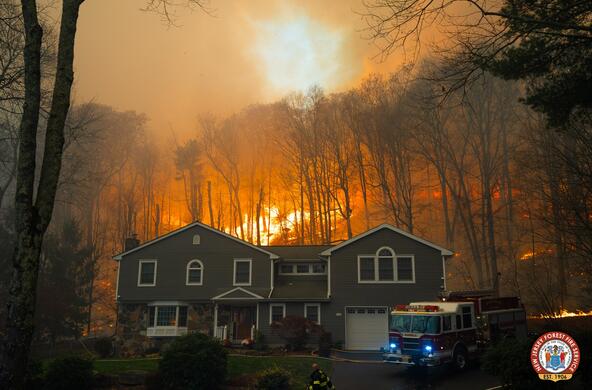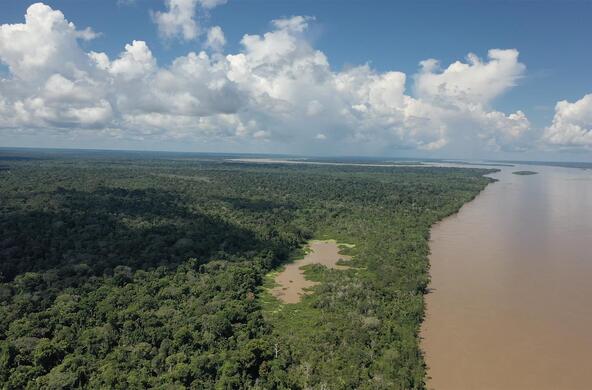In the Adirondacks, a new 14,600-acre nature preserve will protect Follensby Pond, a unique and climate-resilient ecosystem made famous as the site of Ralph Waldo Emerson’s ‘Philosophers’ Camp’ in 1858.
The new conservation agreement is the result of a collaboration between New York State Department of Environmental Conservation and The Nature Conservancy, and is based in part on the research of Cary scientist Chris Solomon.

“Follensby is a pretty stunning example of an Adirondack lake in its ‘natural’ condition,” said the aquatic ecologist. “It's big, the water's clear, there are mountains all around you, and there’s almost no development in the watershed.”
Solomon’s research provided a roadmap for sustainable management of Follensby’s unusual “heritage” lake trout population, highlighting its vulnerability to overexploitation. His team also uncovered evidence for unusual migratory behavior by cisco, another at-risk species of cold-water fish that lives in the lake.
“Chris’s work led us to completely revisit our initial thinking about how we should protect Follensby, by documenting the importance of freshwater species and the need to develop a conservation strategy focused on both terrestrial and freshwater resilience in the face of climate change,” said Dirk Bryant, Director of Lands at The Nature Conservancy in New York.
The relatively untouched lake is surrounded by healthy forests, mineral-rich rocks, and more than 1,400 acres of wetlands, all included in the new nature preserve. And thanks to its depth of 102 feet and elevation of 1,545 feet, Follensby Pond is expected to remain cold and resilient even in the face of climate change — unlike many of its neighbors. As the climate gets warmer, only about 5% of Adirondack lakes are likely to continue to maintain water that’s cold and oxygenated enough to support species like lake trout and cisco.
A special population of lake trout
In 2013 and 2014, Solomon and his lab built a population model of Follensby Pond’s lake trout. The work was funded by The Nature Conservancy, and completed while Solomon was a professor at McGill University.
To understand the population size and structure, the team captured lake trout, marked each one and took measurements, then returned them to the lake. On later trips, they tracked the recapture rate to estimate the overall population size.
Solomon and his team estimated that there were about 7,300 lake trout in Follensby Pond. And, unlike many lakes that have been extensively fished, Follensby hosted a decent proportion of large, old-age lake trout. Findings suggested they reach sexual maturity at 13 years old, and some of the catches were estimated to be as old as 24.
“It's a very special lake trout population,” said Solomon. “Back before there was extensive fishing pressure on lake trout in North America, there would have been lots of populations like Follensby’s, where the fish are abundant and grow to large sizes. But because lake trout grow slowly and mature late, it's so easy to fish them down. Populations like this don't exist in many places anymore.”
Getting a clearer picture of the population size and structure allowed Solomon’s team to assess the risks and benefits of various fishing management strategies. For example, they compared impacts on lake trout populations if fishermen were allowed to take only the largest fish, versus only harvesting the smallest ones. Based on Solomon’s findings, The Nature Conservancy decided not to allow any fishing at Follensby Pond, although other types of recreation will be permitted nearby.
“The lake trout assessment demonstrated that public access would basically eradicate what has been termed an ‘old growth’ population of a species that is particularly vulnerable to climate change,” explained Bryant. “Those findings, combined with other research, highlighted both the opportunity and need to protect the lake and surrounding watershed as a freshwater research preserve — not only for lake trout, but for other species at Follensby as well.”
One of those species, Solomon’s team learned, is cisco — a cold-water fish whose populations are declining due to climate change, overfishing, and competition from invasive species. While investigating Follensby’s lake trout, Solomon and his team noticed the cisco entering the lake from an adjoining stream. After netting some of the fish and taking measurements, they figured the cisco might be migrating to Follensby to spawn — the first time this behavior has been documented in a small inland lake.
“For me, that's an example of how much biodiversity there is out there,” said Solomon. “It seems like a really unique and unusual way for this species to make a living. That's part of why biology and the natural world are so amazing. There is so much variation out there.”
The Nature Conservancy and its partners plan to use Follenbsy Pond and the surrounding area as a research preserve. Solomon expects there will be much scientific value in continuing to study this nearly pristine lake and watershed, providing a better understanding of how the natural world works and how it is changing over time.
In addition to hosting future research, the preserve will be accessible for recreation, education, and Indigenous cultural practices — all while protecting the extraordinary ecosystem and the value it holds for future generations.






